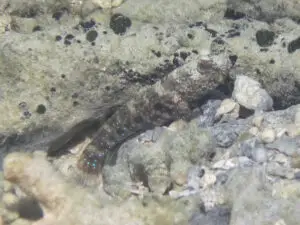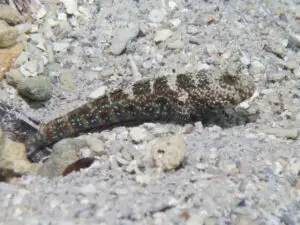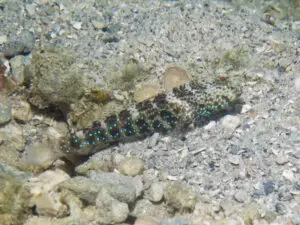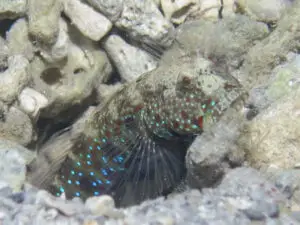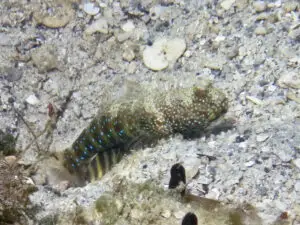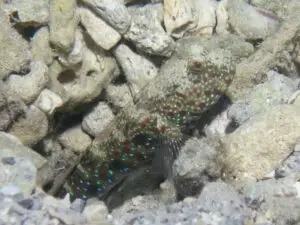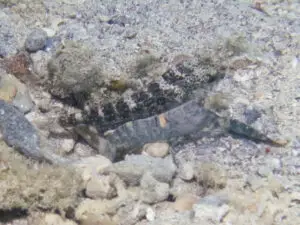Bluespotted Shrimpgoby
Amblyeleotris caeruleomaculatus
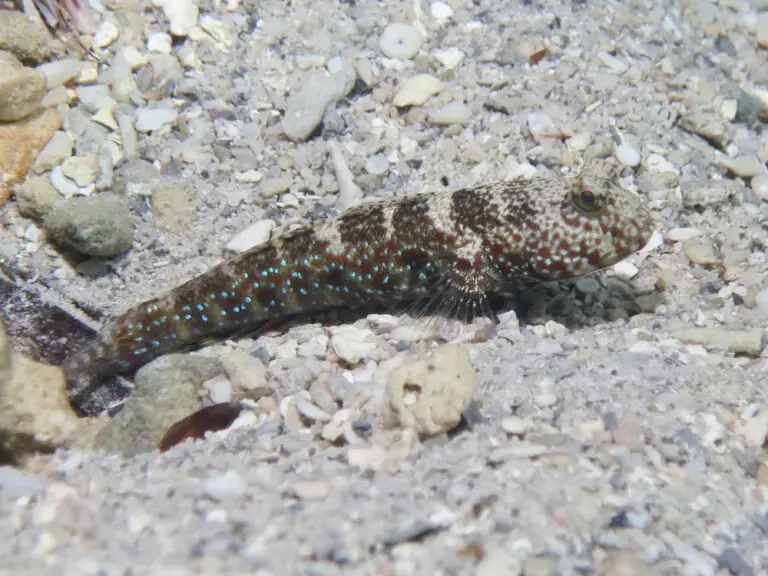
Bluespotted Shrimpgoby
Cryptocentris caeruleomaculatus
(Herre, 1933)
Description
Body design The body is brown, densely speckled with red, blue, black and white spots. The head is white and there are seven white saddles on the brown of the back, though the colours are impure because of the overlay of speckling. Mid laterally there are six black circular patches, each surrounded by a ring of iridescent blue spots which are a part of a more general pattern of similar spots. The brown of the body is interrupted by fine faint bars which are continuations of the pale saddles. They are not conspicuous and no part of the body is free of spots.
Head design The cheek, as far back as the operculum, is a mosaic of red, white and blue spots on a yellow green to brown background.
Fin design The first dorsal fin is triangular,translucent with the rays picked out in alternating brown and white sections. There may be a sexual difference in fin length but they rarely raise their fins so it is hard to see this feature. The second dorsal fin is rectangular with a similar brown and white pattern on the fin rays. The effect may be of a translucent fin with brown spots. The pectoral fins are transparent with three brown arcs and a proximal line of fine white dots. It originates from an opaque base which is a white extension of the second dorsal saddle, decorated with red-brown patches. The anal fin is diagonally banded in alternating brown and yellow. The Caudal fin is translucent with dark fin rays.
Diagnostic features
At the burrow entrance adopts a hunchbacked attitude like C strigilliceps and other close relatives. Large rounded head. Iridescent blue spots surround the black circles on sides. These are very distinctive. Crooked white band over shoulder.
Pale mottled face that blends in with the background
Similar species
There are a number of similar species but none of them have the row of blue encircled ‘targets’ on the side
C leucostictus has eight distinct white saddles, the first of which is usually continuous with the white patch on the top of the head. The pectoral fin has a white patch centrally.
C maudae Is similarly speckled making the white saddles less distinct, but the line of ‘targets’ is absent. . The pectoral fin has fine white speckling.
C strigilliceps is similar and also has a row of ‘targets’ but the head has conspicuous diagonal brown bands. The refllective blue spots are more restricted to the ‘targets’,
Cryptocentrus albidorsus, the White-back Shrimpgoby is uniformly white the whole length of the dorsum.
Cryptocentrus nigrocellatus, the Blackspot Shrimpgoby has a large distinctive ocellated spot just in front of the pectoral fin.
Natural History
Habitat
Found in shallow to very shallow lagoon half a metre deep at mid tide and bounded by a single row of mangroves. Depth varies from 2 metres at high tide to so shallow that the burrow entrances are exposed at low tide. Substrate sand, fine and coarse coral rubble with algal growth. Individuals living in the algae are greener than those on sand.
Behaviour They look like short fat slugs at the burrow entrance. Hunchbacked appearance like C strigilliceps. Large rounded head. Iridescent blue spots surround the black circles on sides. These are very distinctive. Crooked white band over shoulder.
Sometimes they blend so well with algae that they simply disappear, as the photo shows.
Distribution
Published distribution:. Andaman Sea to Solomon Islands, and north-eastern Australia to Micronesia and Ryukyu Islands.
Our records: Our records are from Low Isles in the northern Queensland.
Associated Shrimp species
Associated Shrimp (one shrimp)
Pale Marbled Snapping Shrimp, Alpheus djiboutensis

